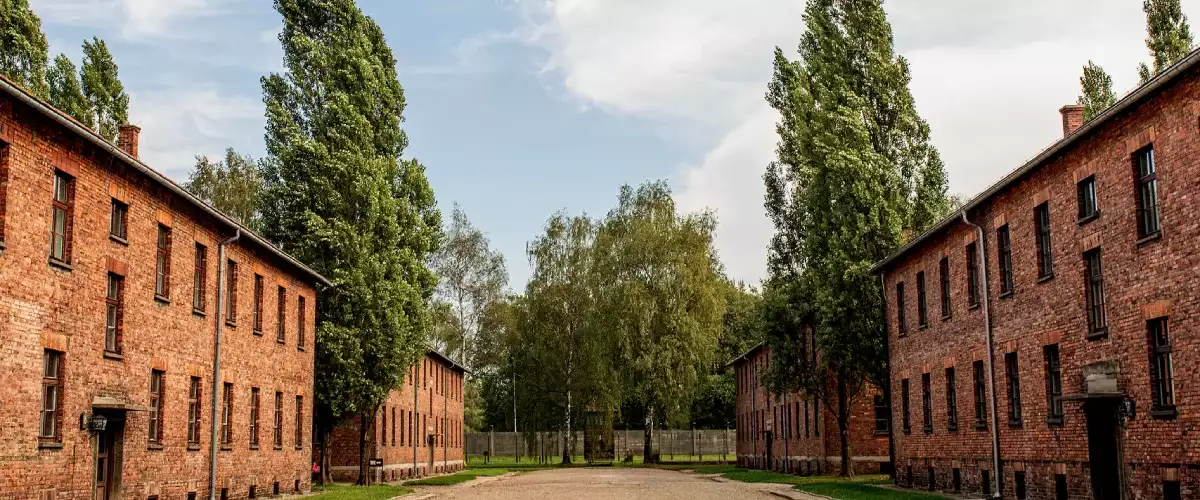
The German Nazi Concentration and Extermination camp in Auschwitz, Poland has been the stage of one of the deadliest operations in the history of mankind. Auschwitz has been opened between the years 1940 and 1945, when the Soviet forces ended up liberating the camp. Over 1.5 million prisoners ended up detained at the camp, out of which 1.3 million people died at Auschwitz.
This article features history of Auschwitz concentration camp during World War II. We have a separate article about the history of the Auschwitz Museum.
First deportations to Auschwitz concentration camp
After the defeat of the Polish Army in the 1939 September Campaign, Poland was conquered and Oswiecim and its surrounding areas were incorporated into the borders of the Third Reich. The Polish name Oswiecim was changed to Auschwitz. Overcrowded prisons and the growing resistance movement in the General Government necessitated the need for a new confinement site for all detainees. Eventually, Oswiecim was chosen as a place where concentration camp might be established. The crucial factor was its strategic location between the Third Reich and General Government, with excellent railway connections.
On June 14, 1940, 728 Polish political prisoners from Tarnów were deported to Auschwitz camp. From that moment onwards, the camp steadily developed, increasing its significance as a concentration camp for the Nazis.
Since the first transport trains with prisoners flowed into Auschwitz. They were usually overcrowded and unventilated. These conditions made the long travel to the camp an anguish. Even though the wagons were escorted, few prisoners managed to escape. Upon reaching the camp, people were on the verge of physical exhaustion, sometimes they died during the transportation. The unloading of the rail transports took place on ramps: one was located near the main camp. The second ramp, the so-called Judenrampe (or “the Jewish Ramp” in English) was located halfway between the two camps. The third ramp, built in 1944 was located within the Birkenau camp. It’s the same infamous ramp you probably know from the pictures. Upon arrival, prisoners had to give back entire belongings, their hair was cut and then they were taken to the bathhouse and received the camp clothes.
The reality of life in the concentration camp
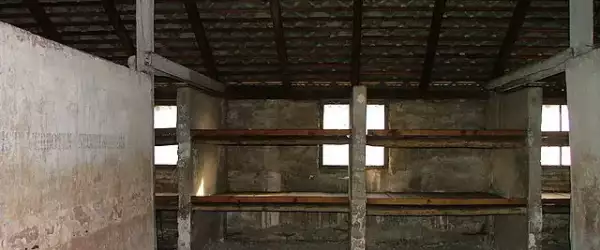
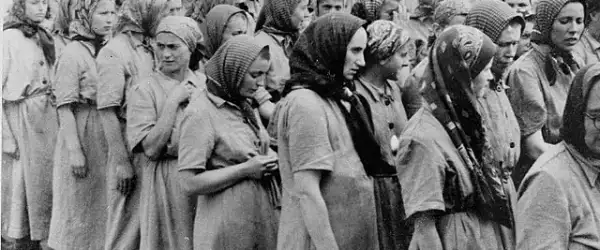
In the early days of the Auschwitz camp, most detainee rooms had no beds nor furniture. Prisoners slept on mattresses piled on the floor. At the beginning of February 1941, bigger bunk beds were equipped, furniture and coal-fired stoves were added. Due to the lack of space in the barracks, it was decided to enlarge the rooms and install washrooms on the second floor of each block. However, amount of sanitary facilities was too low for such number of prisoners.
What they ate
Three meals were served to prisoners during the day. Breakfast was half a liter of boiled water with a small amount of grain coffee or a mixture of herbs called tea. For lunch, a liter of soup containing potatoes and rutabagas was served, along with small amounts of porridge, flour and a flavor-enhancing spice. Dinner usually consisted of a quarter-kilogram piece of bread and side dishes such as sausage, margarine or marmalade of poor quality. Such low-calorie meals, combined with the enormous effort made by the prisoners caused very rapid emaciation of the body and starvation sickness, which could lead to death. In mid-1942, when families were allowed to send packages for their loved ones, the nutritional situation improved.
Their daily regime
The day started at four o’clock in the morning. The sooner the prisoners assembled for roll call and were counted, the sooner the roll call ended. Then the work commandos were formed and set out for the work site along the sound of the orchestra. Working hours averaged eleven hours and usually lasted from 6 to 7 PM. An one-hour lunch break was included, but it was not always respected.
Upon their return, prisoners were searched, then an evening appeal was carried out and the dinner was served. Appeals were among the least liked parts of the day by the prisoners; they were a place of mockery and derision, infliction of pain, and lasted up to a dozen hours regardless of the season if a prisoner escaped. Curfew began at 9 pm, and leaving the housing blocks after that time risked being shot by an SS man.
How the situation progressed
As the camp’s existence progressed, the prisoners work became more varied. Initially, the enslaved worked on the expansion of the main camp, where they were engaged in demolishing houses and leveling rubble or working in the gravel pit. Many prisoners were also engaged to work in the camp’s various economic and administrative facilities. These included warehouses as well as workshops such as locksmiths, carpenters, glaziers, painters, tailors, shoemakers and automobile repairers. There were also camp offices, kitchens, hospitals and sick rooms. The farms were also seized by the Nazis. The entire complex at one point had six large farms that specialized in poultry, fish, flowers and vegetables. Farm work was mainly done by women. As time passed, more and more prisoners worked at the numerous Auschwitz sub-camps, working mainly at industrial facilities: chemical, mining and metallurgical. The biggest one was Auschwitz III Monowitz. These facilities were far away from the original camp so it was more profitable to settle a certain number of prisoners there permanently than to transport them every day. Prisoners usually worked together with civilians in groups of several people. These brigades included professionals who gave orders to the prisoners, mainly directing them to construction work: digging ditches or land reclamation.
Some prisoners were also sent to so called “Sonderkommando”. They were employed to operate equipment used for mass extermination, removing bodies from gas chambers and burning them in crematoria or on pyres, as well as transporting, sorting, storing and shipping stolen property of victims.
Book your tour now and grab a free Walking Tour
Auschwitz-Birkenau hospitals
The hospitals in Auschwitz-Birkenau were staffed by prisoner doctors, and the SS doctor who made the most important decisions regarding the future of patients there. After short inspection, the SS doctor decided whether to send people to the hospital.
Medicines for pain, fever, cough, diarrhea starvation were available, but the amount was insufficient to cover the hospital’s needs. A major threat to the patients were the selections carried out by the SS among the sick to eliminate the weakest people through intracardiac injections of phenol or sending them to the gas chamber.
The hospital barracks were also the site of various medical experiments carried out on selected groups of prisoners. They were carried out because of central orders to find alternative forms of destruction for a particular race, to bolster racist theories, to improve the health of soldiers or to test drugs on behalf of German pharmaceutical companies. Sterilization is an example of such experiments. Successful research in the post-war future was intended to guarantee a controlled and gradual reduction in the population of Jews, Romanis and Slavs to increase living space for Germans. Infamous Dr. Joseph Mengele dealt with other subjects: socking, twinning, different coloration of the iris of the eye and a little-known disease erupting in the camp – water cancer – which was a loss of soft tissue in the cheek area. He began his experiments with studies on Romani children: twins and those who had congenital physical dysfunctions. Initially, they consisted of taking precise measurements of the body parts of the undressed children. Blood was tested, and plaster casts of jaws and teeth were photographed and made. Patients then were killed with intra-arterial injections of phenol and proceeded to the autopsy. When examining twins, the siblings had to die at the same time so that the postmortem analysis could take place simultaneously.
Auschwitz II Birkenau – the largest of the concentration camps
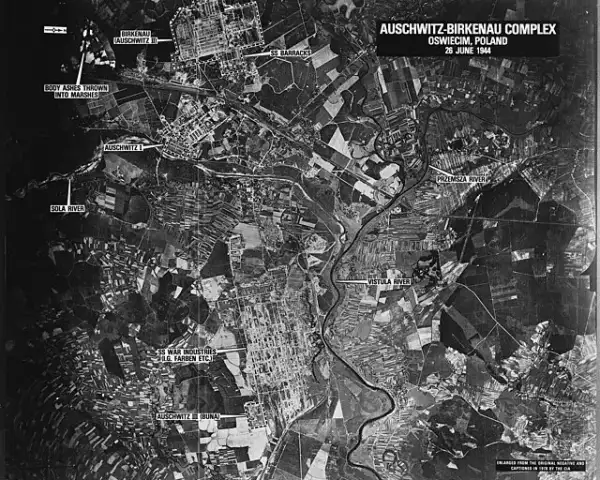
Map of the town of Oswiecim in the year 1944; the 3 major concentration camp sites are all marked here
In March 1941 Heinrich Himmler visited Auschwitz. After his inspection, new orderds were made: the expansion of Auschwitz and the creation of a camp in Birkenau for prisoners of war. The work in Birkenau started six months later. The Auschwitz-Birkenau camp complex soon become the the factory of death. Birkenau camp inmates lived in both wooden and brick barracks, which were only built in the oldest part of the camp, BI. The brick barracks had 1 entrance, 17 windows and 2 air vents, while the sleeping area was made up of brick partitions divided into 3 levels, thus creating 180 bunk beds. According to the plans, about 700 prisoners were to live in such a barracks. These barracks were not heated. The second type of buildings designed for prisoners were wooden stable barracks, initially designed for horses. They had no windows, instead there were skylights in the upper part of the roof. The entrance was a large gate-like door. Very poor sanitary conditions were perfect environment for rats, lice and worms to infest the inside of the building. In July 1942, Himmler visited Auschwitz for a second time. As a result of the inspection, he ordered that the construction of the Birkenau camp should be accelerated, that prisoners unfit for work are to be eliminated and that the armaments companies should be expanded. By August 1942, two separate camps designated as Camp BIa had been built at Birkenau. In the first half of August 1942, women from Auschwitz were transferred to BIa and a women’s concentration camp was established there. The pace of construction of the new camp was tremendous. In 1943, building section II ([BII]) was completed. Six residential camps were built there. In August 1943, a quarantine area was established in Camp BIIa for newly arrived prisoners. In Camp BIIb, a family camp was established for Jews from Terezin. Section BIIc was initially used to store items seized from the murdered Jews. As a result of the constant defeats suffered by the Wehrmacht in 1944 the Third Reich authorities ordered the commanders to begin preparations for the evacuation of the camps. Camp liquidation was carried out by extermination of the weakest, gradual deportation deep into the Reich of prisoners capable of work and destroying evidences of holocaust.
Extermination of Jews in Auschwitz death camp
The first major attempts to use Zyklon B as a way of mass extermination took place in September 1941 in the basement of Block 11. The first victims were Soviet prisoners of war and some patients in bad condition from the camp hospital. Due to the difficulties caused by the closure of Block 11, the gassing site was changed to the morgue located next to the crematorium. Further tests of Zyklon B on Soviet prisoners of war were carried out there, and it was finally chosen as the main way of mass extermination. The extermination was carried out secretly at the time. Soon a new place was establish in Birkenau that served as a gas chamber. This was a regular house of one of the residents of the village of Brzezinka, where the interior was remodeled, the windows were bricked up and holes were made in the walls for Zyklon B cans. The place was called Bunker No. 1, where 800 people could be killed at a time. In July 1942, when Jews were deported to Auschwitz-Birkenau, selection of the arriving transports began. The new arrivals were divided into two groups: men, women and children. Then SS doctors on the basis of appearance, age and a brief interview carried out the selection.
Those who were recognized as fit to work were directed to the camp where they were registered as prisoners and assigned with numbers. The rest was taken to the gas chambers. Before entering the chamber, people were directed to special barracks where they had to undress. About 800 people were entering the chamber, which was divided into two rooms, at a time. After locking the bars with bolts and tightening it, trained SS disinfectors let Zyklon B gas through holes in the walls. Death of the people inside the gas chamber occurred within minutes as a result of internal “asphyxiation”. The gas chamber was then ventilated and Sonderkommando proceeded to pull gold teeth, remove jewelry and cut long hair. Then the corpses weretaken away in a special cart. Initially the corpses were buried in mass graves, but later they were burned on special pyres and in crematoria. In order to obliterate the evidence, mass graves were unearthed and the bodies inside were burned. The ashes from the burning were used along with the ashes to fertilize fields, fill swamps or simply poured into ponds and lakes. Due to the increased influx of transports in the summer of 1942, another residential building was converted into a gas chamber. It was called Bunker No. 2 and could accommodate 1,200 people.
However, both of these bunkers as well as the incineration pits were only ad hoc solutions. The construction of gas chambers and crematoria began in mid-1942 and were put into operation one by one: crematorium IV, crematorium II, crematorium V and crematorium III. In theory, the crematoria could burn 4756 corpses per day, but in practice their capacity was up to twice as high. At the peak of the Nazi death machine’s toll – in the spring and summer of 1944 – with the new burn pits, the operation of Bunker No. 2 was resumed. The gas chambers at crematoria II and III were underground and could fit up to 2,000 people. Gas chambers IV and V had similar capacities, but they were located on the surface. A special unit called the “Sonderkommando” handled all the work of operating the gas chambers and crematoria, transporting and burying the bodies. It consisted of prisoners, usually of Jewish nationality and its numbers varied over the course of the camp’s existence. They were housed separately in blocks specially set aside for them. Most of them were killed after a few months of work, and new ones were appointed in their place. One of the last tasks of Sonderkommando members was to obliterate traces of Nazi crimes.
Liberation of Auschwitz in January 1945
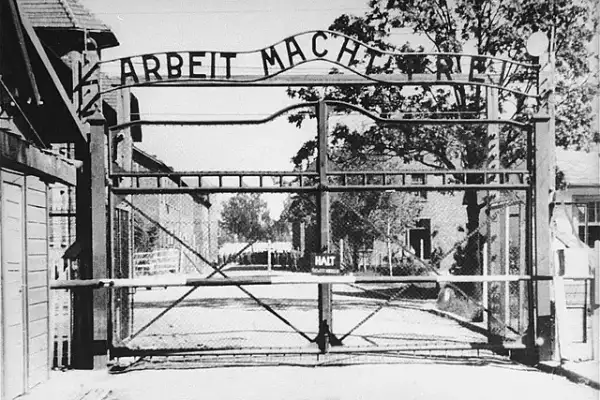
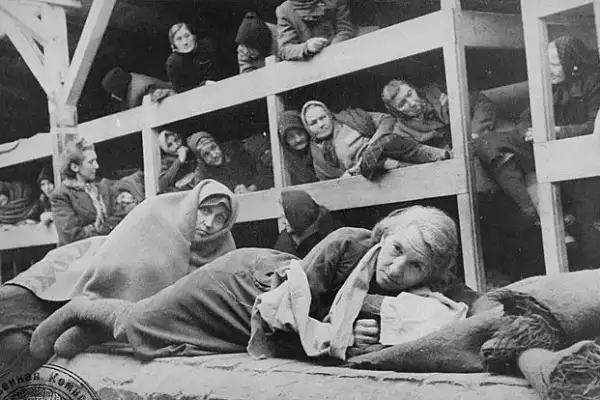
The changing situation on the front line at the end of the war forced the authorities of the Third Reich to take action to dismantle the concentration camps and erase the traces of mass crimes. By November 1944, most members of the Sonderkommando and other witnesses of the extermination were killed. It was also the moment when the mass extermination of Jews ceased. In the second half of January 1945 crematorias were blown up. One of the warehouses, “Canada” was also burned. From the second half of 1944, the number of prisoners sent to work in industrial plants within the Third Reich area increased significantly. During the final evacuation, when columns were formed in so called death march, around 9,000 people were left on the campgrounds. They were inconvenient witnesses of Nazi crimes, who were supposed to be killed, but due to the pervasive chaos and disorganization among the SS most of them were left alive. They lived to see liberation, which came on January 27, 1945 from the 60th Army of the 1st Ukrainian Front advancing from Krakow. A small number of liberated prisoners were able to come back home, where they returned either on their own or by organized transport. However, the vast majority of former prisoners needed medical attention. This came most quickly from Soviet military doctors and the local population, so that after a few days field hospitals were established there. Also important was the help of the Polish Red Cross, which set up a Camp Hospital under the direction of Dr. Jozef Bellert of Warsaw.
Auschwitz – Holocaust Memorial Museum
With 1.3 million of victims Auschwitz-Birkenau death camp became the symbol of the Holocaust. It serves as a memorial to those who suffered and lost their lives at the hands of the Nazis. The site encompasses both Auschwitz I, the main camp, and Auschwitz II-Birkenau, the larger extermination camp where mass killings occurred.
Today this is one of the most important tourist sights in the world, with at least 1 million people visiting Auschwitz since 2006. The museum aims to educate visitors about the Holocaust and foster a sense of remembrance, reflection, and dialogue. It is crucial to approach a visit to Auschwitz with sensitivity and respect.
FAQ
What is the Auschwitz Concentration Camp famous for?
Auschwitz Birkeanu Concentration Camp is a symbol of holocaust with over 1.1 million victims killed there.
Was Auschwitz the biggest concentration camp created?
Yes, Auschwitz was the biggest concentration camp, with the area of 191 hectares and number of victims extending 1 million.
Who created the Auschwitz Concentration Camp?
Auschwitz was established in 1940 by the German Nazi State, originally for the polish political prisoners.
How many prisoners were there in the Auschwitz Concentration Camp?
1.3 million prisoners went through Auschwitz Concentration Camp.
How long did the Auschwitz Concentration Camp last?
Auschwitz was established in April 1940 and was liberated in January 1945, so the camp existed nearly 5 years.
How many Jews died in the Auschwitz Concentration Camp?
Approximately 1.1 million Jews were killed in Auschwitz Concentration Camp.
When were the Jews freed from the Auschwitz Concentration Camp?
Auschwitz was liberated on 27th of January 1945.
How many people survived the Auschwitz Concentration Camp?
It is estimated that there were 1.3 million prisoners in total, with total number 1.1 million people killed, approximately 200 thousands people survived Auschwitz.
How were the Jews tortured at the Auschwitz Concentration Camp?
From medical experiments in hospitals, through extremely hard work, poor nutrion and sanitary conditions to beating, flogging or post punishments.
What can we see when we visit Auschwitz Concentration Camp today?
Auschwitz I with exhibitions presenting personal items taken from prisoners, as well as documentation, photographs, and information about the history and operations of the camp. In Auschwitz II-Birkenau there are: iconic train tracks leading into the camp, the remnants of gas chambers and crematoria, and the vast expanses of barracks.
Can visitors view all the camps at the Auschwitz Concentration Camp?
No, as Auschwitz was a complex of approximately 40 subcamps, the farthest were established around 160 km from the main camp it is not possible to see them during the visit in Auschwitz Museum.
Is the Auschwitz Concentration Camp a UNESCO World Heritage site?
Yes, Auschwitz is on UNESCO World Heritage site from 1979.
Does the Auschwitz concentration camp still exist?
The area of the former German Nazi concentration camp was preserved and from 1947 it serves as a museum.